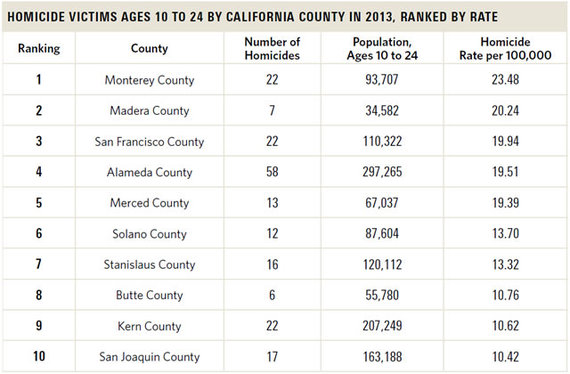
What's the second leading cause of death for California youth and young adults ages 10 to 24? Sadly, the answer is homicide -- nearly always committed with a gun.
Every year, in California alone, hundreds of young lives are cut short by homicide with a firearm. The organization I head, the Violence Policy Center, just released the fifth edition of our annual study Lost Youth: A County-by-County Analysis of 2013 California Homicide Victims Ages 10 to 24. This report, the most comprehensive study of its kind, takes an in-depth look at homicides among youth and young adults in California. It is based on data for 2013, the most recent year for which data was available at the time of research.
This year's study is available both in English and in Spanish and uses unpublished information from the California Department of Justice Supplementary Homicide Report as well as data from the federal Centers for Disease Control and Prevention.
As our study shows, youth homicides in California are inextricably linked with the availability of guns. Statewide in 2013, when the murder weapon could be identified, 83 percent of the homicide victims ages 10 to 24 died by gunfire. Of these, 69 percent were killed with a handgun.
We also found that the risk of a young person becoming a homicide victim does not fall evenly. Overall, of the 653 homicide victims we identified ages 10 to 24, 90 percent were male and 10 percent were female. For blacks in this age group, homicide was the leading cause of death in 2013. For Hispanic youth it was the second leading cause of death, and for whites and Asian/Pacific Islanders it was the fourth leading cause of death.
To provide more information for local communities, our study also analyzes youth homicide data at the county level. We identified the 10 counties with the highest homicide victimization rate for youth and young adults ages 10 to 24 (see chart below). In 2013, Monterey County had the highest rate, followed by Madera, San Francisco, Alameda, and Merced.
What can we learn from this research? First, in order to reduce gun violence among youth and young adults, we must reduce access to guns. Federal law prohibits those under the age of 21 from purchasing a handgun, yet our report reveals it is the most common type of firearm used in homicides. Lost Youth cites the need for additional study on the firearms (including make, model, and caliber) used and how the killers obtain them.
For local communities, we hope our report shows that information is power and that the data contained in it will help support tailored, localized approaches to make communities safer. Throughout California, community organizations, government agencies, and state and local institutions are working to reduce violence among youth and young adults, employing approaches that emphasize prevention, intervention, and opportunity rather than punishment and incarceration.
As Manny González, assistant county administrative officer in Monterey County, told the Monterey Herald, communities would fare well by treating gun violence among youth as the public health crisis that it is.
"We do know that a public health approach while keeping (federal recommended practices) can be successful. Like many of our law enforcement partners may have stated, 'we cannot arrest our way out of the problem.'"
Some additional details in our study include:
•In 2013, the homicide victimization rate for black youth and young adults was 48.12 per 100,000, nearly 16 times higher than the homicide victimization rate for white youth and young adults, at 3.05 per 100,000. The homicide victimization rate for Hispanic youth and young adults was 8.21 per 100,000, more than two and a half times higher than the rate for white victims.
•When the race of the victim was identified, 49 percent of the homicide victims were Hispanic, 36 percent were black, 11 percent were white, and 3 percent were Asian/Pacific Islander.
•The homicide victimization rate for black males ages 10 to 24 was 86.76 per 100,000. For Hispanic males it was 14.28 per 100,000, for white males it was 4.88 per 100,000, and for Asian/Pacific Islander males it was 3.28 per 100,000.
•The homicide victimization rate for black females in this age group was 7.17 per 100,000. For Hispanic females it was 1.80 per 100,000, for white females it was 1.09 per 100,000, and for Asian/Pacific Islander females it was 0.64 per 100,000.
•For homicides in which the victim to offender relationship could be identified, 38 percent of the victims were killed by someone they knew and 46 percent were killed by strangers. An additional 15 percent were identified as gang members.
•The overwhelming majority of homicides of California youth and young adults were not related to any other felony crime. For the homicides in which the circumstances between the victim and offender could be identified, 80 percent were not related to the commission of any other felony. Of these, 60 percent were identified as gang-related.
•For homicides in which the location could be determined, 52 percent occurred on a street, a sidewalk, or in a parking lot. Seventeen percent occurred in the home of the victim or offender, 11 percent occurred at another residence, and 8 percent occurred in a vehicle.
All too often, the immediate, devastating effects of violence and its aftermath are little recognized outside of those who are directly affected. With this annual report, it is our goal to provide a new, ongoing context for information to be presented and progress to be measured, while at the same time helping support discussion, analysis, policy development, and action.


